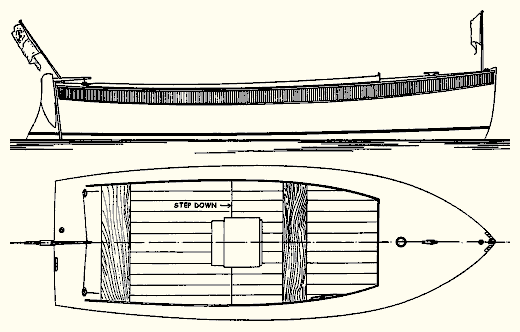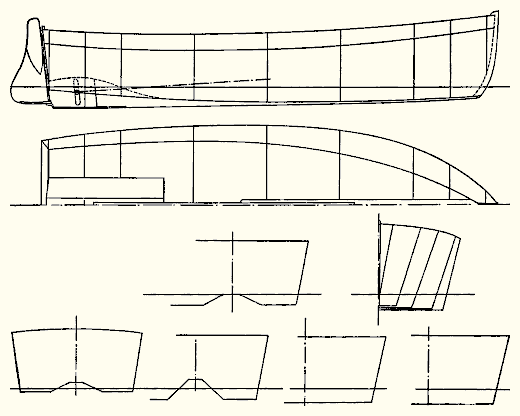

In Twinkle we have a little boat that will be very useful in all those lovely shallow reaches of the river, the coves of the sea, and shale bottomed lake shores that jut out for miles some places on fresh water. But you cannot expect this little honker to go blue fishing off soundings, or to stem those bad waves that stand on end when the wind blows strong against the current of some mighty river. Twinkle was not designed for sea-going; but she will perform safely and exceptionally well in sheltered waters and if given reasonable intelligence in handling should be able to take a bad dusting.

The deck plan shows simplicity and a straightforward job to build as designed. Cockpit is square ended both ends; modest decks forward and aft and narrow side decks. There are two seats making excellent room for four persons in comfort and safety. The motor will be installed beneath a little motor house to keep in the noise and keep out things that are likely to become wound up in the shaft coupling. The boat steers with a side lever which is about the simplest way of taking care of this very important detail. There is really quite a lot of room in the boat and ample depth to place the passengers well below the level of the deck; in other words people aboard sit down in the cockpit rather than on the boat -- there is a big difference between the two.

Twinkle is 16 feet 2 inches in over all length; 15 feet 6 inches on the water line; 5 feet 10 inches in breadth; and draws only 9 inches of water -- this with three average weight persons aboard. For a little boat she has a lot of freeboard, a feature which never hurts any motor boat. The topsides have generous flare the entire length of the boat; but there is no flam or vertical curve to the sides. Easier to build this way and to all intents and purposes just as good this way. The bottom is flat, and not too wide in the forward sections. The tunnel is an improvement over the regulation square box type. It is simply a depression in the bottom of correct shape athwartships and fore and aft to induce the water to flow uphill to the propeller and then sweep out through the small orifice in the bottom of the stern. If built just like the plans show it will work perfectly because I have tried it in other boats of similar design. This form of bottom is a little more efficient than the square tunnel type; but not as efficient as the box deadwood model having negative deadrise aft as exemplified in my designs like Everhope, Heron, and Islamorada, to mention a few.
It will be seen that Twinkle can be run up on the shore without anything striking, only the flat bottom or the heavy skeg. And it is very unlikely that drift wood or snags will tangle with the propeller tucked up in the depression in the bottom. A boat of this shape is an easy one to move on a trailer or truck as it needs neither blocking or bilge poppets. Wherever she is she will sit on an even keel.
The motors in all boats seem to present a problem to most owners. It seems to me after a great many years of experience that the cheapest in the beginning is not always the best to buy; may end up as the most costly, I am sure that any of the well known and standard types that have been on the market these last many long years will give every satisfaction and thus it comes down to little more than personal preference as to which to install. For Twinkle I would not go over 10 h.p.; and 3 h.p. will be ample for speeds up to six miles an hour. Remember Twinkle is not a racing boat.